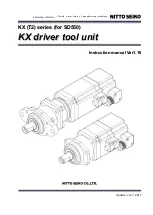
8
Rockwell Automation Publication PFLEX-UM003D-EN-P - June 2021
General Description
Stop Category Definitions
The selection of a stop category for each stop function must be determined by a risk
assessment.
•
Stop Category 0 is achieved with immediate removal of power to the actuator,
resulting in an uncontrolled coast to stop. See “Description of Operation” Example
1 on
•
Stop Category 1 is achieved with power available to the machine actuators to
achieve the stop. Power is removed from the actuators when the stop is
achieved. See “Description of Operation” Example 2 on
Performance Level and Safety Integrity Level (SIL) CL2
For safety-related control systems, Performance Level (PL), according to
EN ISO 13849-1, and SIL levels, according to IEC 61508 and EN/IEC 62061, include a
rating of the system’s ability to perform its safety functions. All of the safety-related
components of the control system must be included in both a risk assessment and
the determination of the achieved levels.
See the EN ISO 13849-1, IEC 61508, and EN/IEC 62061 standards for complete
information on requirements for PL and SIL determination.
PFDavg and PFH Definitions
Safety-related systems can be classified as operating in either a Low Demand mode,
or in a High Demand/Continuous mode.
•
Low Demand mode: where the frequency of demands for operation made on a
safety-related system is no greater than one per year or no greater than twice
the proof-test frequency.
•
High Demand/Continuous mode: where the frequency of demands for operation
made on a safety-related system is greater than once per year or greater than
twice the proof test interval.
IMPORTANT
When designing the machine application, timing and distance should be
considered for a coast to stop:
•
Stop Category 0 or Safe Torque Off
•
Stop Category 1 or Safe Stop 1 - Time Controlled
For more information regarding stop categories, see EN/IEC 60204-1 or IEC
61800-5-2.









































